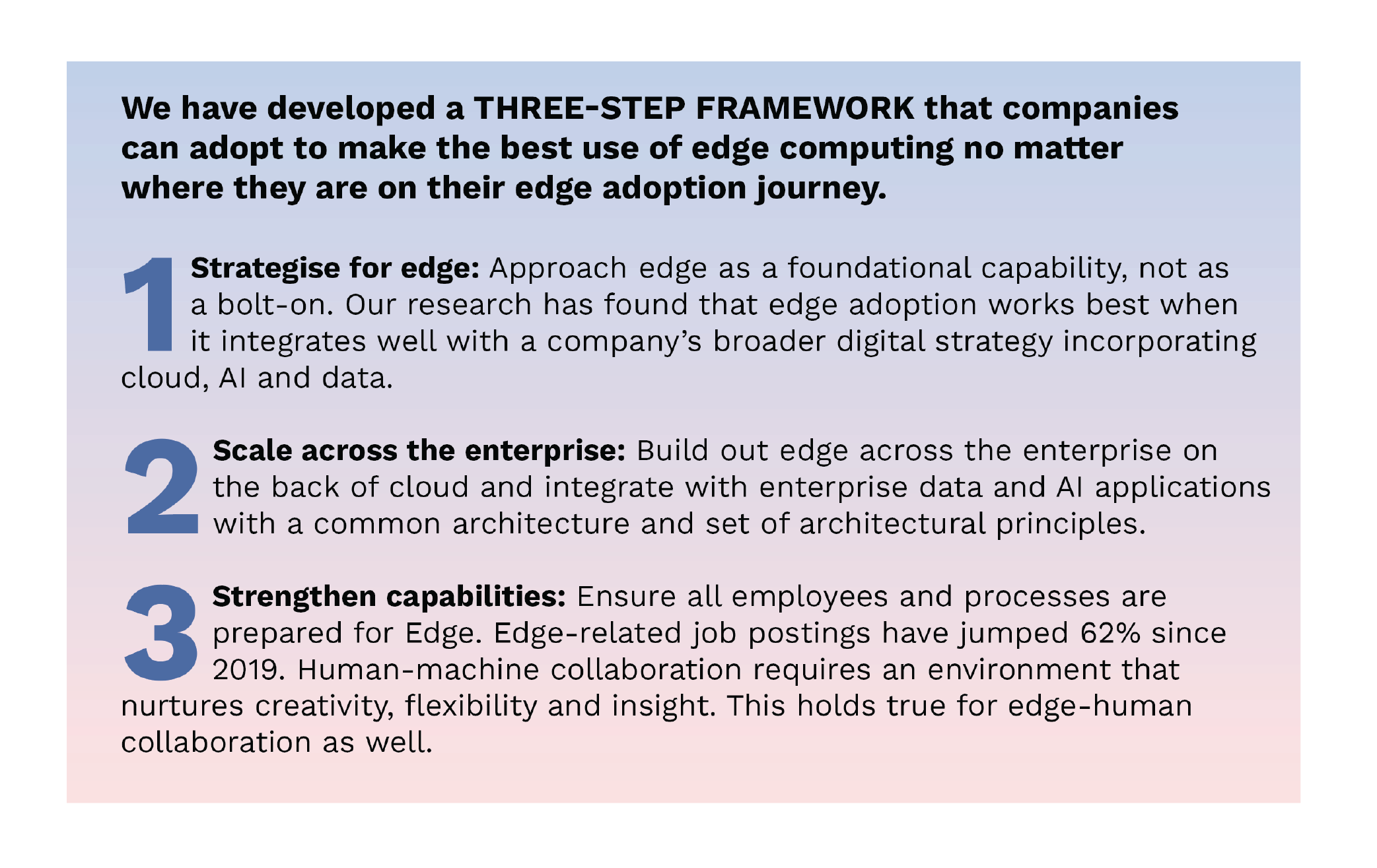By Ram Ramalingam, Teresa Tung, Nitu Kaushal & Shalabh Kumar Singh
Edge is an essential component of the cloud computing model and has the potential to help enterprises increase speed of action, reduce network costs and boost efficiency. But rapid adoption or higher investment is not enough to get the best value from edge computing. Integration of edge with the enterprise’s overall cloud adoption strategy is the way forward.
KEY TAKEAWAYS
- 83% of our survey respondents believe that edge computing will be essential to remaining competitive in the future but only 65% are using edge today.
- Super Integrators—edge adopters that tie edge to business in transformation adoption—comprise just 6% of edge adopters across the globe and 5.5% of those in Europe, but gain the most in terms of efficiency, cost reduction and capitalising on revenue opportunities.
- Our three-step framework for optimal edge adoption includes strategising for edge, scaling edge across the enterprise and strengthening allied capabilities such as operations and human resources.
Edge computing, in step with an overall cloud strategy, can play a major role in bending enterprises’ innovation curve. Much of innovation today comes from companies that adopt solutions informed by the staggering amounts of data generated in branch offices, on individuals’ health trackers, retail stores, remote oil rigs, manufacturing plant sites, hospitals and even satellites. In most cases, it is inefficient to move all of this data back to a central data centre for real-time analysis. And real-time complex analytics right where the data is produced – be it on the factory floor, on an individual’s health tracker or at the store checkout counter – have the potential to drive the next wave of performance improvement across industries.
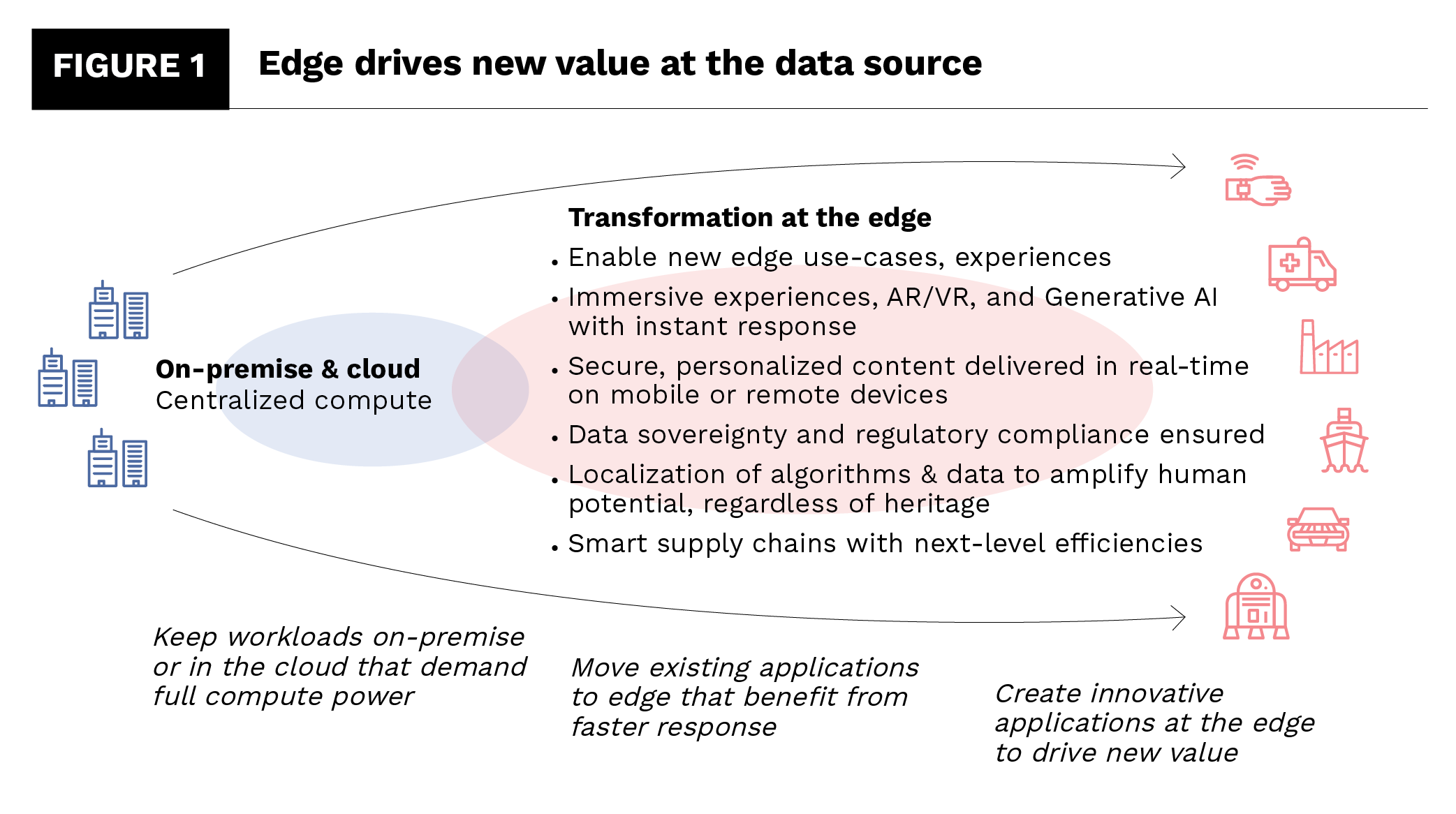
We see several examples of edge adoption in many industries. Take the case of a UK-based international energy services company that designs, builds, operates, and maintains oil, gas and renewable energy assets. It wanted to increase efficiency, productivity and safety at its project sites during the critical construction and commissioning phases. The Internet of Things (IoT) enabled the collection of data from sensors, equipment and workers. Edge computing enabled onsite analysis of this data to drive real-time improvements in operations, resiliency, worker safety and security.
In retail, Starbucks combines in-store IoT capabilities with cloud computing to run real-time analytics on the machines used by baristas for personalising orders and for predictive maintenance.1
In auto and transport, Tesla has created its own chipset to custom-build a supercomputer that trains the AI systems within the car, which will rely on data from at-scale AI training across its fleet.2 Heathrow Airport is experimenting with AI combined with 3D scanning on edge to prevent wildlife trafficking.3
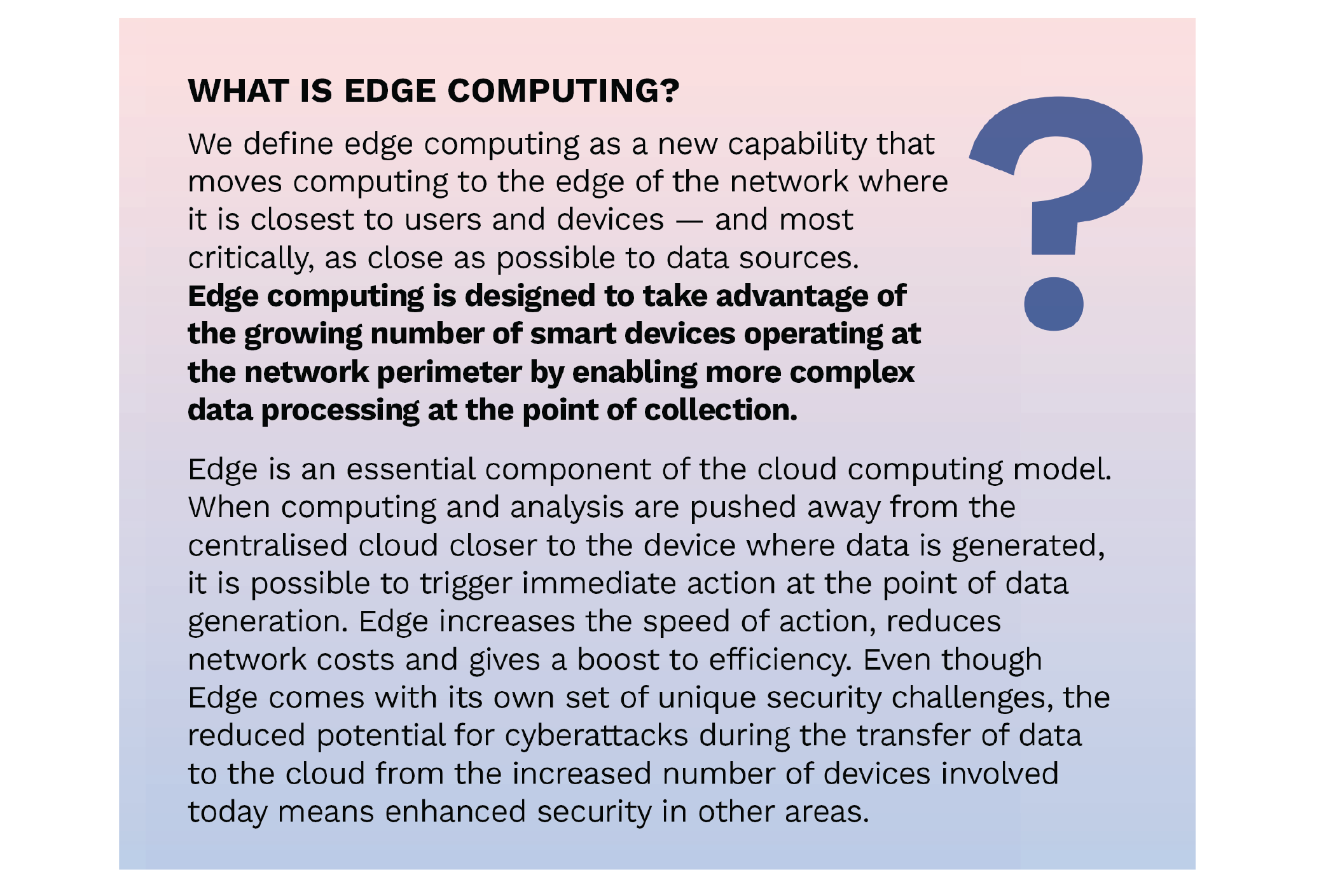
For our research report, “Leading with Edge Computing,4” we surveyed 2,100 C-level executives across 18 countries to explore the extent of edge adoption and factors that influence success. We found that while enterprises are convinced about the possibilities edge enables, adoption is yet to reach optimal levels — 83% of our survey respondents believe that edge computing will be essential to remaining competitive in the future but only 65% are using edge today.
However, as we have seen, enterprises across industries are rapidly adopting edge computing to improve performance and reduce latency, essential for deploying levers of reinvention such as AI, including generative AI. While the trend is recent, it is catching up, as our research below shows, and European companies are keeping pace with the rest of the world.
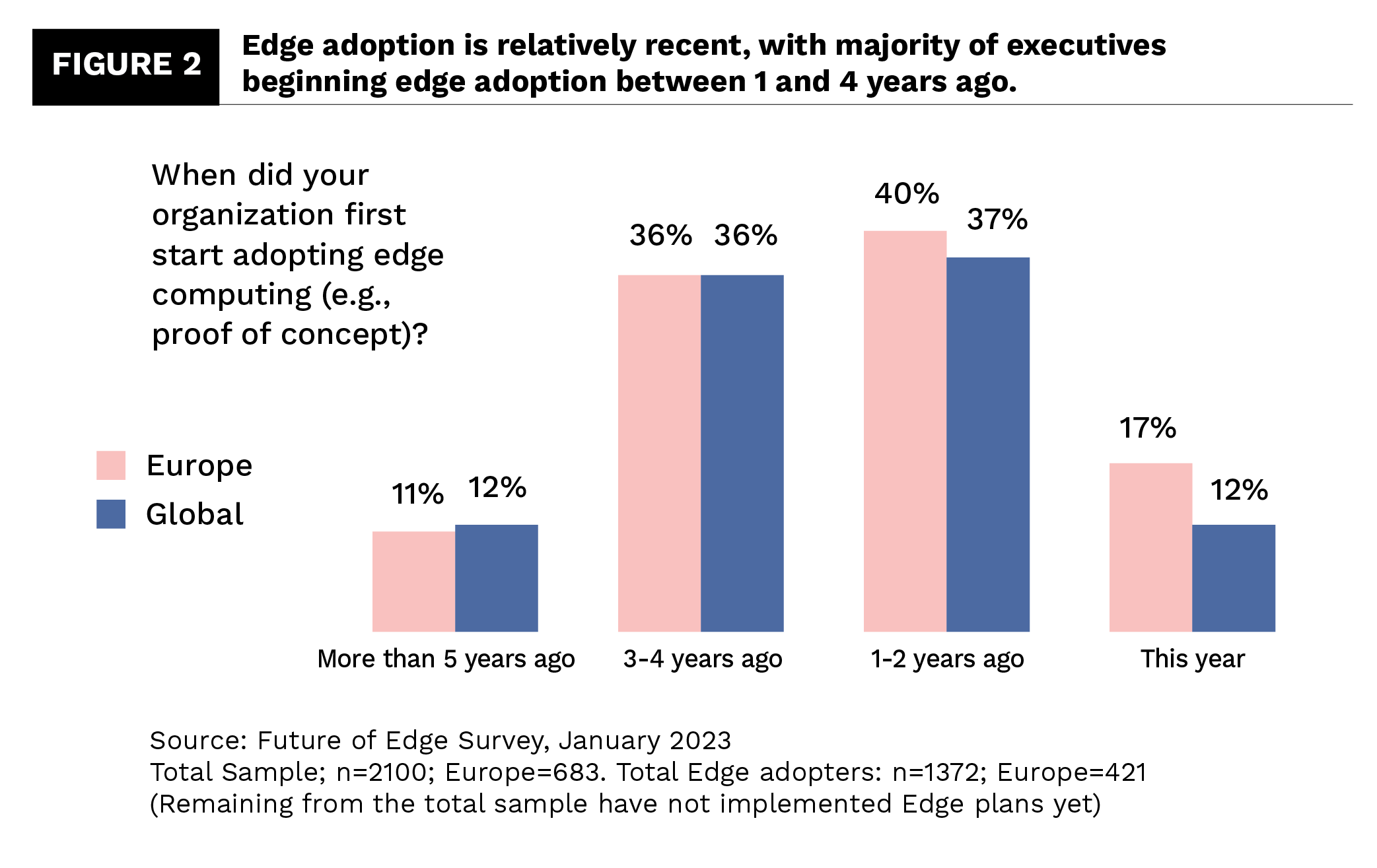
Global spending on Edge is expected to be $208 billion in 2023, a 13.1% jump from 2022. Enterprise and service provider spending on hardware, software and services for Edge is forecast to sustain this pace of growth through 2026 when spending will reach nearly $317 billion.5
Edge in Europe
For European companies, the enhanced data security that edge entails is a major attraction. Concerns about data privacy, supply chain vulnerabilities and uncertainty about where critical data is stored and processed in the cloud are driving many countries to treat digital sovereignty as a regulatory, responsibility and reputational matter. An increasing number of European companies are considering sovereign cloud investments to comply with numerous regulations, but also find it complex to implement.6
Edge is one way to help companies meet data protection regulations, such as GDPR, by restricting the sharing of data over cloud for specific requirements and across limited servers—all with the consent of the user. Accenture’s Sovereign Cloud Survey revealed that to ensure cloud sovereignty, 40% of European enterprises have taken actions to secure their sensitive data at the edge, while 55% have plans to do so in the next 2-3 years.
As Europe focuses on taking manufacturing to the next level by establishing smart factories, edge computing can come into play in many ways. It can improve quality assurance by fine-tuning automation and reducing variation in output through onsite analysis of data. Manufacturers that need to locate computing closer to the site of production to enable smart, connected systems – which can be cumbersome and expensive – could look to edge computing for a solution. Edge is also critical for incorporating artificial intelligence, including generative AI, in industry, enabling data analysis in real or near real-time and delivering key business insights.
Edge computing is also a step towards sustainable computing. Data centres and transmission networks consume a significant 1-1.5% of the world’s electricity produced today, and their energy use continues to grow.7 While data centres are moving towards greener practices such as more efficient cooling mechanisms and renewable energy usage, edge can contribute too by reducing unnecessary data traffic between devices and the cloud.8 Gartner predicts that with edge computing, just 25% of enterprise data will need to be uploaded to the cloud by 2025.9
Aiming for an integrated approach to edge adoption
Getting the most out of edge requires more than mere installation and investment. Accenture’s research shows that edge adoption challenges conventional management wisdom. The fast adopter doesn’t necessarily have the greatest advantage overall. Half of the companies we studied adopted edge as a standalone technology on ad-hoc projects (following the Ad-hoc or Tactical approaches in the figure below) to achieve quick improvements to their bottom line and address immediate pain points rather than strategic improvements. While this enables learning and some smaller, faster outcomes, these are not the companies that achieved the best results. Our cluster analysis shows that neither early adoption led by a centralised digital team nor higher investments to address specific business needs led to optimal outcomes.
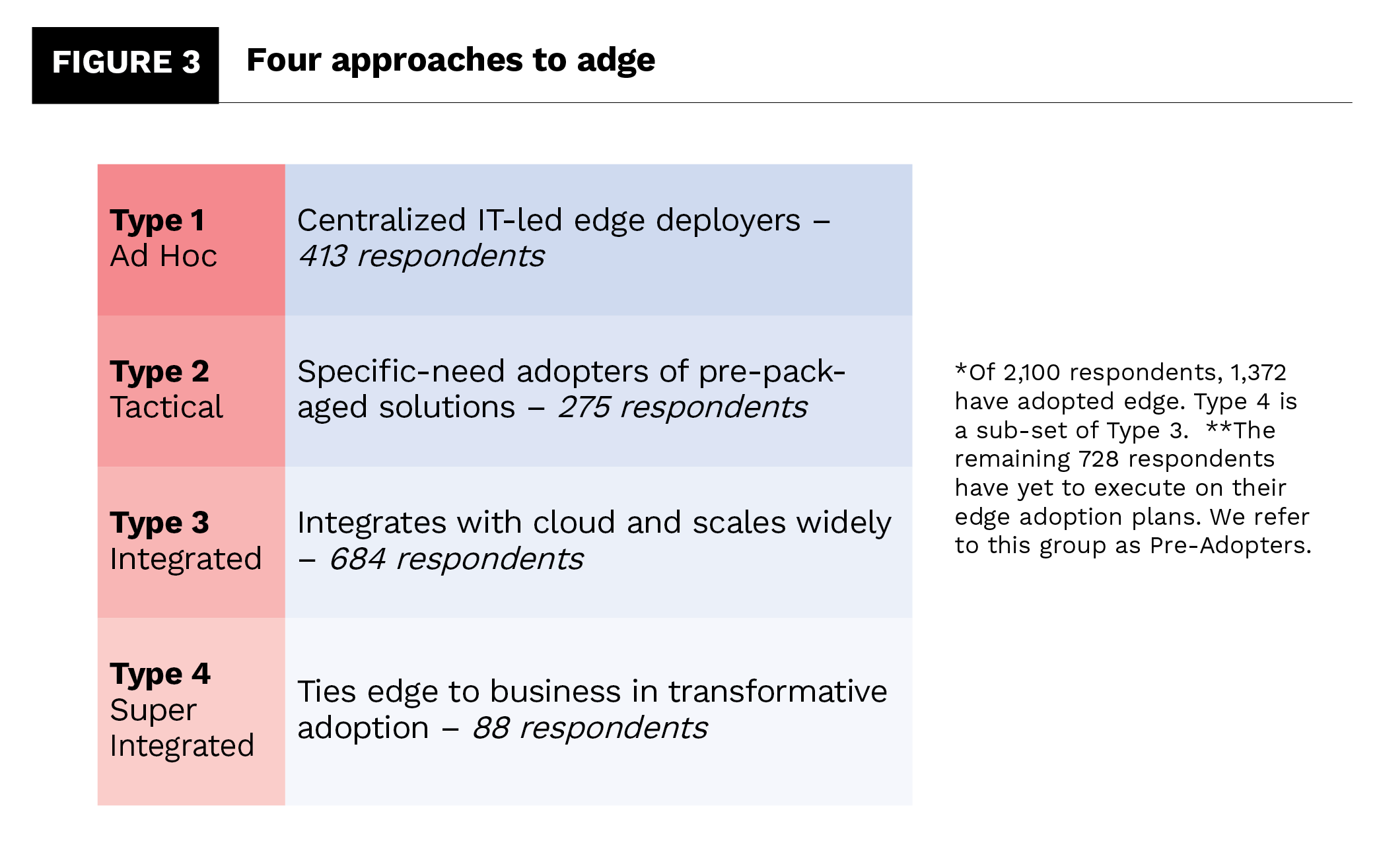
The other half, which applied edge across all parts of their business (the Integrated or Super Integrated approach), saw better outcomes. They operated with a view that edge increases the value of their digital core and enables the integration of artificial intelligence into their core business. Edge helped them accelerate innovation and reduced costs, improved efficiency, led to new revenue opportunities and enabled better customer experience. The differentiating factor was the strategic approach to edge adoption and its integration with a broader cloud strategy.
Unsurprisingly, the Super Integrated approach delivered the best results. Super Integrators comprise a small group of companies – 6% of edge adopters across the globe, and 5.5% of those in Europe. Our research shows that Super Integrators are 4x more likely to achieve accelerated innovation, 9x more likely to increase efficiency and nearly 7x more likely to reduce costs than those that follow the Ad-hoc approach.
This is because Super Integrators made the best use of the digital core’s range of technologies – cloud, data, AI, applications and platforms – using edge to make quick innovation decisions. They could also enhance digital capabilities with human talent.
Not all companies can or need to aspire to be Super Integrators, but any level of integration provides future-proof resilience as their tech footprint and digital core expand.
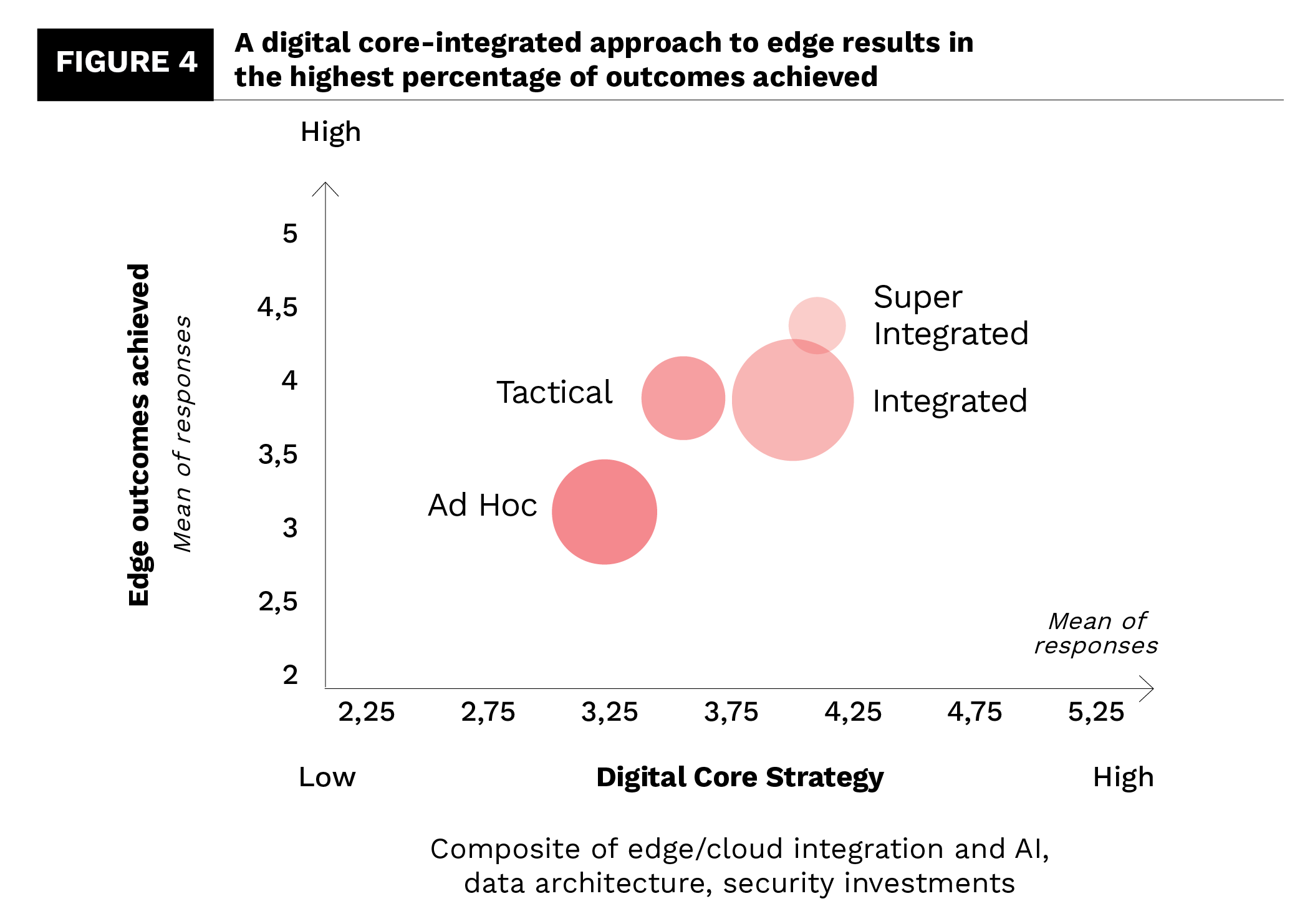
How to unlock the value of edge
Edge implementations often begin with relatively narrow objectives but should be designed with broader applications in mind.
The oil and gas enterprise mentioned earlier believes that edge will be a key part of its broader strategy in the future, which includes AI and blockchain. With these technologies, it hopes to achieve its goal of being a net-zero energy business by 2050.
It realised early on that though deploying edge had to initially be geared towards local conditions where the use case would be customised to factors such as geographic location and weather, the successful use case would need to be scaled across multiple locations globally.
The company has created a horizontal function that focuses on standardising use cases and now has approximately 40 edge assets. It used multiple providers for cloud services as well as outside consultants for edge implementation and turned to key technology original equipment manufacturers (OEMs) for edge-related systems and devices.
The result: reduced unplanned downtime, which can cost the company up to 10% of its revenues.
It also launched its edge talent strategy by working with a leading systems integrator while simultaneously establishing an edge Centre of Excellence to build a pool of relevant internal talent. This approach gives the company the flexibility to adjust the internal/external talent ratio as conditions warrant.
A three-step framework
The future of edge
Current trends indicate that edge adoption is gaining momentum globally. By 2028, 38% of the edge infrastructure footprint will be in Asia Pacific, with 29% in Europe and 21% in North America.10 The full potential of technologies like IoT and AI can only be harnessed through the simultaneous strategic deployment of edge computing. This is a major opportunity for European enterprises to be at the forefront of technology deployment and establish themselves as lead players in their respective industries.
Most of the companies that participated in our research believe that edge will be a transformative force—one that leads to innovative business models over the next three years.
However, the right approach is an important distinguishing factor between making the most of this technology versus using it in stop-gap solutions. Aligning edge with the business strategy, integrating it with the digital core and garnering support from all stakeholders is the key to successful adoption.
The authors would like to thank Jai Bagmar, Toms Bernhards Callahan and Ramani Moses for their contributions to this article.
About the Authors
Ram Ramalingam is the senior managing director and global lead for software & platform engineering and intelligent edge at Accenture.
Teresa Tung is managing director and global CTO of Cloud First, data and AI, at Accenture.
Nitu Kaushal is managing director and Europe practice lead, intelligent edge, at Accenture.
Shalabh Kumar Singh is the principal director and global lead for sustainable technology and cloud-related thought leadership at Accenture.
References
-
1 Starbucks Turns to Technology to Brew up a More Personal Connection with its Customers, Microsoft, https://news.microsoft.com/source/features/digital-transformation/starbucks-turns-to-technology-to-brew-up-a-more-personal-connection-with-its-customers/
-
2 Tesla Starts Production of Dojo Supercomputer to Train Driverless Cars, The Verge, July 2023, https://www.theverge.com/2023/7/19/23800854/tesla-driverless-dojo-supercomputers-production
-
3 HRH The Duke of Cambridge Visits Microsoft’s UK Headquarters to Learn about Project SEEKER as Part of His Work with The Royal Foundation, Microsoft, November 2021, https://news.microsoft.com/en-gb/2021/11/18/first-of-its-kind-multispecies-ai-model-to-detect-illegal-wildlife-trafficking-is-ready-to-roll-out-to-airports/#:~:text=HRH%20The%20Duke%20of%20Cambridge%20met%20Microsoft%20UK,work%20with%20The%20Royal%20Foundation%E2%80%99s%20United%20for%20Wildlife.
-
4 Leading with Edge Computing. Accenture. https://www.accenture.com/content/dam/accenture/final/accenture-com/document-2/Accenture-Leading-With-Edge-Computing.pdf#zoom=40′
-
5 New IDC Spending Guide Forecasts Edge Computing Investments Will Reach $208 Billion in 2023, IDC, February 2023, https://www.idc.com/getdoc.jsp?containerId=prUS50386323
-
6 Sovereign Cloud Comes of Age in Europe, Accenture, https://www.accenture.com/content/dam/accenture/final/accenture-com/document/Accenture-Sovereign-Cloud-PoV-Short-2023-24-May-FINAL.pdf#zoom=40
-
7 Data Centers and Data Transmission Networks, IEA, https://www.iea.org/energy-system/buildings/data-centres-and-data-transmission-networks
-
8 Uniting Technology and Sustainability, Accenture, Uniting Technology and Sustainability | Accenture https://www.accenture.com/content/dam/accenture/final/a-com-migration/pdf/pdf-177/accenture-tech-sustainability-uniting-sustainability-and-technology.pdf#zoom=40
-
9 Computing on the Edge Can Be Transformative – But Look Before You Leap, Forbes, March 15, 2021, https://www.forbes.com/sites/forbestechcouncil/2021/03/15/computing-on-the-edge-can-be-transformative—but-look-before-you-leap/?sh=64836186f3a5
-
10 LF Edge’s State of the Edge 2021 Report Predicts Global Edge Computing Infrastructure Market to be Worth Up to $800 Billion by 2028, the Linux Foundation, March 2021, https://www.linuxfoundation.org/press/press-release/lf-edges-state-of-the-edge-2021-report-predicts-global-edge-computing-infrastructure-market-to-be-worth-up-to-800-billion-by-2028




